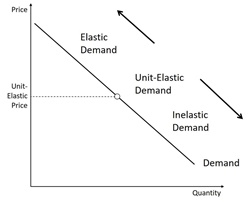What is Arc Elasticity?

Arc Elasticity can be defined as the elasticity measured between two variables at a certain point. You could obtain the arc elasticity of two variables by evaluating the ratio of the percentage change of one variable to the other one. It is important to note that arc elasticity is always measured between two points. Point elasticity, on the other hand, is absolutely different from arc elasticity. That’s because, in the point elasticity, the distance between these variables will reach zero, which is calculated as a single point instead of two points.
The value of the arc elasticity is almost never the same. It may vary based on the starting point. Take the elasticity of the supply and price, for example. The elasticity of the supply of any item at a given point will be larger as compared to the price of the same product. This occurs when the starting as well as ending cost of the product is lower than estimated. At the same time, the elasticity of the supply of these products is going to be small if the prices are high. The most common use of arc elasticity is when you don’t have any general formula or a function to find out the relationship of one variable with another. Arc elasticity has many applications in mathematics, but it has also become one of the common elements of Economics.
Arc Elasticity Formula
The formula for calculating the arc elasticity is:
PE = percentage change in one variable/percentage change in another
Note that the negative signs in the price and Demand Elasticity are not taken into consideration. Even if the equation involves a negative value, its negative sign is ignored. As mentioned above, arc elasticity is mainly used in mathematics as well as economics. There are mainly two methods for measuring the elasticity of demand, i.e. either through point elasticity or arc elasticity. The price elasticity is mainly used to calculate the connection between the prices of the material with its quantity demanded.
Talk to our investment specialist
While the price elasticity formula is applicable to all situations, the major issue people face with the formula is that it never provides you with the exact value. Whether the price of the material increases or decreases, you are always going to find some variations in the price of the material. To avoid such issues, people use arc elasticity. In arc elasticity, the midpoint is used to measure the elasticity percentage. The formula for calculating the elasticity of demand is given below:
Arc Elasticity of Demand = [(Qd2 – Qd1) / midpoint Qd] / [(P2 – P1) / midpoint P]
The major benefit of using arc elasticity is that the individual does not have to worry about calculating and considering the starting as well as the ending point. Unlike price elasticity, arc elasticity will help you generate the exact value regardless of the price. This method works wonders when there is a significant variation in the cost.
All efforts have been made to ensure the information provided here is accurate. However, no guarantees are made regarding correctness of data. Please verify with scheme information document before making any investment.







